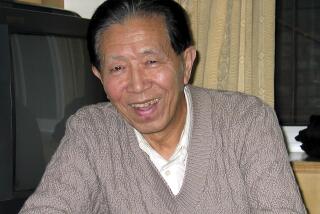Panic attack
- Share via
PICTURE Guangdong province, circa 2002 -- a virtual paradise of luck and prosperity. “To get rich is glorious,” Deng Xiaoping had proclaimed years earlier, opening the door to a new era of enterprise. Now, in China’s south, music blares, cellphones ring, cigarette smoke curls and petty tycoons flush with cash consume every kind of exotic meat from camel hump to pangolin ear. The growing passion for “Wild Flavor” cuisine has spawned a flourishing trade. In crowded warehouses, slaughter chambers and restaurant kitchens slimy with entrails and excreta, hundreds of caged creatures destined for affluent diners nervously await their fate.
Welcome to the riotous breeding ground of severe acute respiratory syndrome, or SARS, an infection that will soon “species-jump” from animals to people. A few early cases were probably directly linked to Guangdong’s wild-animal markets. By the close of 2003, however, SARS’ causative agent -- a coronavirus found in civet cats, rodents and various badgers -- had somersaulted person-to-person into more than 8,000 humans, killing 1 in 10.
“China Syndrome: The True Story of the 21st Century’s First Great Epidemic,” Karl Taro Greenfeld’s journalistic tour de force on the SARS epidemic, is rich with the sights, sounds, smells and still-sclerotic politics of today’s China. Greenfeld was the Hong Kong-based editor of Time Asia magazine when the mystery ailment surfaced. As a paid decoder of paradoxical messages in mainland newspapers, it didn’t take him long to spot a big story and a potential cover-up in the offing. Consider, for example, these lines published on Jan. 3, 2003: “There is no epidemic in Heyuan. There is no need for people to panic” -- described by Greenfeld as “one of the least-reassuring reassurances I have ever come across.”
But months would pass before researchers, editors or anyone else would learn the actual cause of the clouded chest X-rays and terminal breathlessness of the victims in Guangdong, Hong Kong, Hanoi, Toronto and beyond. Or how to stop it from spreading. Meanwhile, Asian commerce and travel withered; Hong Kong became a ghost town; and Greenfeld, having moved his wife and children to a safer locale, subsisted largely on Chicken McNuggets.
Meanwhile, in China, tensions had mounted between the nation’s health authorities and Western disease-fighting forces. A crack team convened in February 2003 by the World Health Organization was stalled for weeks before being allowed to investigate the epicenter of SARS in Guangdong. Two intrepid Time staffers, seeking viral footprints in Beijing (a city that officials claimed was virtually free of the scourge), conducted daring, unannounced visits to hospitals and clandestine meetings with whistle-blowers. During the former, the reporters found healthcare personnel suspiciously outfitted in high-tech respiratory masks; during the latter, they received shocking revelations. Finally, in early April, Time’s Chinese website leveled this scathing reproof: “Numerous reports from local doctors over the past week suggest that the nation’s health-care system remains hostage to a government that values power and public order before human lives.” Sometime later, embarrassing details came to light. For example, to preserve the fiction that SARS had not reached Beijing, Chinese officials ordered dozens of sufferers and hospital staff members hastily removed from one of its medical facilities just hours before a scheduled WHO visit.
“China Syndrome” is a fast-moving, truth-is-stranger-than-fiction thriller that doubles as an excellent primer of emerging infections for scientists and laypeople alike. But that’s not all. For readers more captivated by world politics than by microbiology, its chief strength, beyond the superb writing, is a detailed look at China’s culture of secrecy in the throes of a global public health crisis. Then comes the tipping point: Just as dramatically as it suppressed intelligence about the epidemic, in mid-April of that year the Chinese government publicly acknowledged SARS and mobilized to quell it.
Although Greenfeld stops short of equating China’s about-face with a total embrace of transparency, he doesn’t make light of the disease’s political fallout: The mayor of Beijing and the Chinese and Taiwanese ministers of health lost their jobs as a result of the epidemic. Greenfeld’s thoroughgoing reporting also honors the unsung heroes of SARS -- the many healthcare workers who lost their lives to the virus, the scientists who helped to figure it out and others whose courage and toil went far beyond the call of duty. In the final chapters, there’s even some backhanded praise for the Chinese public-health system. Yes, its monitoring and quarantine systems were inept, yet where else but in China, Greenfeld wonders, could quarantines have been as stringently enforced, thus containing the menace?
Dr. James Maguire, a friend of mine, was a U.S. Centers for Disease Control and Prevention delegate on the WHO team, and he clocked more weeks in Chinese hospitals during spring 2003 than any of its other members. When I recently pressed him to describe his experience, he downplayed the risk of his own repeated exposure to SARS (fellow WHO emissaries told him he had a “death wish”) while stressing that his colleagues in China’s Ministry of Health were sincere people working to the brink of utter exhaustion. Once it became clear that Beijing harbored the virus, he also remembers thinking to himself: “SARS is here to stay.” And thus is revealed another truth about emerging viruses: Even experts can’t predict their next move. As it turned out, the last naturally acquired human SARS infection that we know of occurred in December 2003, roughly six months after Maguire left China.
Now that SARS has disappeared from view (at least for a season or two), what lessons can it teach us about the present threat of avian influenza? Dr. Marc Siegel’s slim volume, “Bird Flu: Everything You Need to Know About the Next Pandemic,” contends that the world’s response to SARS was inappropriate panic fueled by self-serving bureaucrats, and that we should all cool our jets over bird flu until it’s really and truly here. That’s easy to say, now that SARS is a receding memory and the H5N1 virus (as opposed to the influenza viruses that plague us every year) has not yet crossed our borders.
To be fair, Siegel, a practicing internist with a second career as a New York-based medical commentator, weaves in many useful and accurate facts about avian flu in the book that, by his own account, he raced to complete. But his 2005 book was titled “False Alarm: The Truth About the Epidemic of Fear,” so one can’t help but suspect that he has a certain bias. Unlike public-health professionals charged with anticipating worst-case scenarios and planning the global means to address them, his daily practice is peopled (as are those of many popular practitioners) with patients whose anxieties sometimes outstrip their common sense. For them, Siegel’s book serves a purpose. Like the good doctor he no doubt is, he exhorts them to focus on what they can do now to protect their health: losing weight and stopping smoking, for starters, instead of staying awake at night over a threat that has not yet descended on humankind in a big way -- and perhaps never will.
More to Read
Sign up for our Book Club newsletter
Get the latest news, events and more from the Los Angeles Times Book Club, and help us get L.A. reading and talking.
You may occasionally receive promotional content from the Los Angeles Times.







